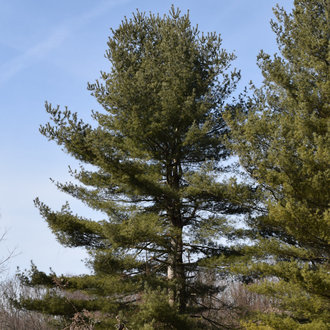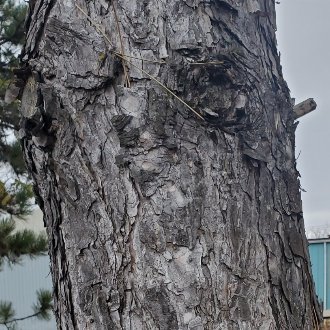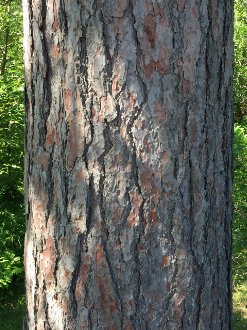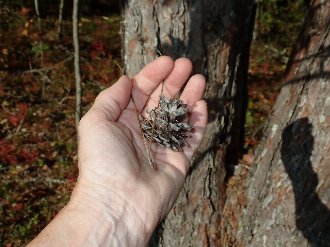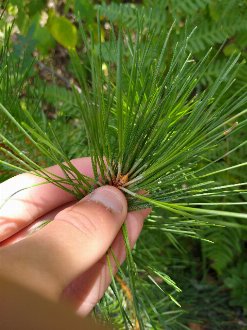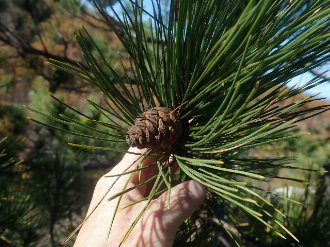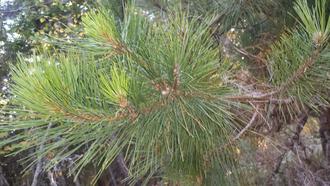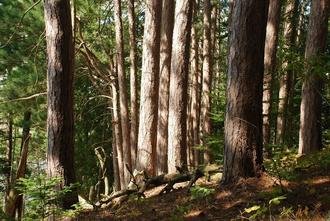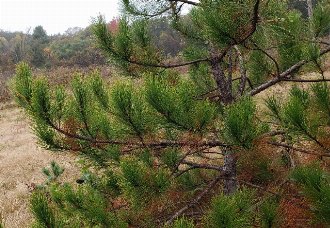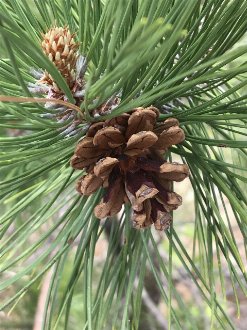Red Pine (Pinus resinosa Aiton)
Also known as Norway pine.
↑Summary
A pine native to northern areas in eastern North America, mostly found on dry, sandy soils, often near lakes; typically requires fire to establish.
↑Range - Expand
| Legend | Color |
| Native or Introduced | |
| Native or Not Present | |
| Introduced | |
| Native | |
| Native or Introduced or Not Present | |
| Introduced or Not Present |
This tentative map is based on our own research. It may have limited data on Canada and/or Mexico, and there is some subjectivity in our assignment of plants as introduced vs. expanded. Read more in this blog post.
Although this plant occurs somewhere in each of these regions, it may only occur in a small part of some or all of them.
↑Similar Plants
↑Habitat
Restricted to a narrow range in the northern forests and slightly into the boreal forests, with a few scattered populations farther south. Most common on sandy soils of low ridges and sand plains adjacent to lakes, also on margins of swamps. Typically found at elevations of 700 to 1,400 feet, but at higher elevations in the south of its range: to 2,000 in New England, 3,480 in New York state, and to over 4,000 in West Virginia. In its southernmost range limits it is found on sandstone bluffs and sandy uplands, often along rivers.
Frequently found in pure stands but also found in mixed-age stands, mixed with other pine species, and also as minor components of a variety of forest types, often as isolated, mature canopy trees over an understory of more shade-tolerant trees, and also found as a minor component in mixed-species cover of pioneer vegetation including aspen or birch.
Found mostly on dry, sandy soils, most commonly those (entisols) with little development of soil horizons and little accumulation of organic matter. Occasionally found on areas with thin accumulation of organic matter over rock outcroppings. Tolerates low nitrogen and phosphorus, but requires significant potassium in the soil. Grows best on soils with pH 5.2 to 6.5, but tolerates soils with pH of 4.0 to 7.5. Generally absent from areas with calcium-rich surface soils, but can occur where a layer of acidic, sandy soil covers limestone or other calcareous bedrock. Most common and vigorous on sites where the water table is 4-9 feet below the surface.
Generally requires fire and typically limited to habitats that experience fire. Frequently colonizes areas that have burned recently. However, absent from areas that experience the most frequent, severe fire. Among the pines in its range, red pine occupies a "middle zone" of habitat in terms of fire frequency and severity, between eastern white pine (Pinus strobus) (preferring less severe fire) and jack pine (Pinus banksiana) (preferring more frequent fire.) On sites protected from fire, red pine is eventually replaced by more shade-tolerant trees.
Although humans have widely planted red pine in plantations, we have also decreased the natural habitat for it through fire suppression.
↑Life Cycle
Red pine is a large and long-lived tree that usually begins its lifecycle as a pioneer species following fire.
Growth starts at 10 inches or less per year for the first four years, then accelerates to 1-2 feet a year, continuing for 10-20 years. Optimal growth requires at least 6 hours of direct sunlight; more shaded grow slower. Maximum height is reached by 60 to 120 years, but diameter growth continues for as long as 200 years.
Trees typically begin producing female (seed) cones before producing male (cones), producing female cones at around 5 years of age but delaying production of male cones until about 9 years. Trees growing on harsher sites may take longer to produce cones. Seed production is best from 50 to 150 years of age.
Seed production is irregular and varied, with light crops most years, bigger crops at 3-7 year intervals, and bumper crops every 10-12 years. Cone production is higher in denser stands and lower for isolated trees. Cone production may depend on weather in complex ways. In years of low seed production, nearly all the seed is consumed by insects.
Most seed is released immediately when ripe, and dispersed by wind, but a small portion of cones remain on the tree for 2-3 years. There is some controversy over whether this species is able to persist in the seed bank; one author claimed seeds can persist for up to 10 years, but studies extracting seeds from litter have failed to germinate them. Another study found that seeds can remain viable for up to 3 years but only under conditions of unusually low rainfall.
Seeds do not have a period of dormancy, and may germinate immediately, but germination tends to occur from spring to summer. Fall-germinating seedlings are typically killed by winter. Seeds germinate best on exposed mineral soil, ideally prepared by fire, but germination is inhibited by light and occurs best in shade, either from post-fire vegetation, or being covered by soil or ash. Germination is triggered by a combination of warm temperatures and moisture.
Seedlings do not compete well with other vegetation, which likely explains this species' restriction to recently-burned sites with nutrient-poor, dry surface soils. Seedling mortality is high and can occur from drought, sun scorching, early freezing, flooding, and browsing by rodents. As trees mature, their abiliy to survive flooding increases, with mature trees nearly always surviving flooding for about a month, occasionally for longer periods.
Red pine cannot resprout and does not reproduce vegetatively. Trees that reach maturity typically live 200-400 years, occasionally as long as 500 years. Trees can be damaged or killed by prolonged flooding (flooding of 3 months or longer will usually kill trees), severe drought that persists through multiple growing seasons, or severe wind.
↑Faunal Associations
The importance of this species to wildlife is more poorly-researched relative to other pines. Pure stands of red pine have often been described as poorer habitat for wildlife overall, but still have key importance for certain species. Several large birds use red pines as nesting sites, including bald eagle, osprey, and great blue heron, with particularly importance for bald eagles. Several warblers nest in this species, although none are strictly dependent on it; it is most important to two species: Kirtland's warbler utilizes habitat where red pine is found, but is more dependent on jack pine, and pine warblers nest in red pines among many other pine species.
Young red pines are only occasionally browsed by larger mammalian herbivores, including white-tailed deer and moose. The foliage is only a minor and occasional component of the diet of these mammals. However, the foliage and bark is more important in the diet of small mammals, particularly snowshoe hares in Canada.
The seeds are an important food source for the American red squirrel, white-footed mouse and meadow vole, and a minor food source for the eastern gray squirrel.
Red pine is also important as a cover plant and roosting site for many birds, including the sharp-tailed grouse in the west, and throghout, barred owl and other owls, evening grosbeaks, and the non-native ruffed grouse. Bats utilize red pine as cover while hunting for insects.
Numerous moth species are supported by red pines, including the coleotechnites flower moth (Coleotechnites florae), pine candle moth (Exoteleia nepheos), pine needleminer (Exoteleia pinifoliella), the large purplish gray moth (Anacamptodes vellivolata), the twin-spot girdle (Caripeta divisata), the small pine looper (Eupithecia palpata), the pine measuringworm (Hypagyrtis piniata), the eastern pine looper (Lambdina pellucidaria), the porcelain gray moth (Protoboarmia porcelaria), the bicolored angle moth (Macaria bicolorata), the blurry chocolate angle moth (Macaria transitaria), the larch lappet moth (Tolype laricis), the northern conifer tussock (Dasychira plagiata), the variegated midget (Elaphria versicolor), the jocose swallow (Feralia jocosa), the moth Lithophane lepida, the variable climbing caterpillar (Xestia elimata), pine false looper (Zale duplicata), brown-spotted zale (Zale helata) and in the south of its range, the northern pine looper (Caripeta piniata), the southern pine looper (Caripeta aretaria). The red pine needleminer moth (Coleotechnites resinosae) specializes on this species, and the redheaded inchworm (Macaria bisignata) specializes on pines, including this species.
It may also support the moth Holcocera immaculella, the powder moth (Eufidonia notataria), the larch pug moth (Eupithecia annulata), the mournful thorn moth (Lambdina fiscellaria), the false hemlock looper (Nepytia canosaria), Owen's larch looper (Macaria oweni), the generalist variable tussock moth (Dasychira vagans) which prefers hardwoods, and the generalist dark-spotted palthis (Palthis angulalis), although we only found sparser evidence that these species feed occasionally on pines, among other conifers, and this species is probably not a preferred host for any of these insect species. The minor angle moth (Macaria minorata), which specializes on white pine, may also eat this species. It is also sometimes eaten by the invasive generalist gypsy moth (Lymantria dispar).
Among butterflies, this species supports the eastern pine elfin (Callophrys niphon).
In addition this species supports numerous other insects, including over 200 species in total, an atypically large amount of insect diversity among pines. Most of these insects do not damage the trees during feeding, but insects cause significant loss to seed crops. The few insects that do cause serious damage to this species, include the pine root collar weevil, which damages the root system, the common pine shoot beetle (Tomicus piniperda) which is an invasive species in North America, introduced from Europe, the also invasive European pine shoot moth (Rhyacionia buoliana), and the native jack pine budworm (Choristoneura pinus), red pine cone beetle (Conophthorus resinosae), and white pine weevil (Pissodes strobi).
↑Uses
Red pine is used for timber, where it is valued for its straight trunk, workability, and even-textured grain. It is mainly used for utility poles, railroad ties, construction lumber, and as pulpwood; historically it was used for ship masts. It is sometimes planted in plantations, including in areas far south of its native range. It is often sold together with mixed conifers, labeled as SPF.
It is rarely used in landscaping, as it does not adapt well to cultivation, and particularly, fares poorly when planted in poorly-drained soils, areas with hot summers, or when exposed to pollution. Its northerly range falls short of most major population centers, and thus most people live in areas where it does not grow well.
Owing to its ease of establishment on exposed mineral soil, and rapid growth, red pine has also been used for rehabilitation of disturbed sites; it can be used as a windbreak or snowbreak, and also to protect watersheds. It is often able to establish and survive on sites too harsh for white pine.
↑Related Plants
Red pine belongs to a group of pines mostly restricted to Europe, and is the only member of this group native to North America. Although most of its closest relatives are not found in North America, two species, scots pine (Pinus sylvestris) and Austrian pine (Pinus nigra) have been introduced here.
Hybrids not only do not occur in nature, but do not seem to occur easily even artificially. With great effort, someone was able to hybridize this species with Pinus nigra in 1955.
↑Notes
The common name "Norway pine" is misleading, as this pine is native to North America and not Norway, and as such we recommend avoiding it.
↑Links & External Resources
• Red Pine | The Wood Database (About This Site)
• Red Pine | Fire Effects Information System (FEIS) (About This Site)
• Pinus resinosa (Red Pine) | Illinois Wildflowers (About This Site)
• Pinus resinosa (Red Pine) | USDA PLANTS Database (About This Site)
• Pinus resinosa | Go Botany (About This Site)
• Red Pine | iNaturalist (About This Site)
• Pinus resinosa (Red Pine) | Missouri Botanical Garden Plant Finder (About This Site)
• Red Pine | Virginia Tech Dendrology Factsheets (About This Site)
• Red Pine | Silvics of North America (About This Site)
• Pinus resinosa | Biota of North America Project (BONAP) (About This Site)
• Pinus resinosa | NatureServe Explorer (About This Site)
• Pinus resinosa | Flora of North America (About This Site)
• Red Pine | Maryland Biodiversity Project (About This Site)
• Pinus resinosa Aiton (Red Pine) | Digital Atlas of the Virginia Flora (About This Site)




